Dogs
Hello Julie,
My, oh my! What an exciting time it was last week, witnessing Dog Spies' migration to the Scientific American Blog Network.
Such a great day for dogs, for science and for YOU!

Yah! for this recognition of your fabulous writing achievements, communicating the field of canine science to a broader audience. WELL DONE!

META-ANALYSIS
You said it. I'm neck-deep in meta-analysis goodness right now and I'd love to tell you more about it.
Well, you see - that's the thing. What is the normal range for salivary cortisol in dogs?
We don't really know.
What is it?
Meta-analysis is a way of evaluating and interpreting the results from research about a particular topic. It adds together the data from different studies, then looks at the compiled data pool to see what patterns and relationships might emerge in the larger body of available information created by the many research projects.
Why use it?
The patterns and groups we might look at within a meta-analysis of salivary cortisol (often used as an indicator of stress/welfare in dog research) are things like:
Can you really do that?
So there you have it. I'm excited about dogs and I'm excited about throwing their data into the compiled data pool. I imagine it will look something like this when we're finished compiling:
When I posted on Facebook about being excited about dogs and pools, you might have expected I'd talk about gene pools. Which is funny, because I wasn't intending to. Except that this week a study opened to collect data and the researchers involved in it ARE interested in gene pools, amongst other things - specifically the breeding, health, training and performance success of working farm dogs in Australia.
I truly hope so!
Mia
Further reading:
Liberati A., Altman D.G., Tetzlaff J., Mulrow C., Gøtzsche P.C., Ioannidis J.P.A., Clarke M., Devereaux P.J., Kleijnen J. & Moher D. & (2009). The PRISMA statement for reporting systematic reviews and meta-analyses of studies that evaluate health care interventions: explanation and elaboration, Journal of Clinical Epidemiology, 62 (10) e1-e34. DOI: 10.1016/j.jclinepi.2009.06.006
Dorey N.R., Udell M.A.R. & Wynne C.D.L. (2009). Breed differences in dogs sensitivity to human points: A meta-analysis, Behavioural Processes, 81 (3) 409-415. DOI: 10.1016/j.beproc.2009.03.011
Fratkin J.L., Sinn D.L., Patall E.A. & Gosling S.D. (2013). Personality consistency in dogs: a meta-analysis., PloS one, PMID: 23372787
Nimer J. & Lundahl B. (2007). Animal-Assisted Therapy: A Meta-Analysis, Anthrozoos: A Multidisciplinary Journal of The Interactions of People & Animals, 20 (3) 225-238. DOI: 10.2752/089279307X224773
© 2013 Mia Cobb
- 2014: Canine Science For All
Wendy74ca's photostream used with permission via Crazy and LittleHi Mia! I couldn’t agree with you more! It has been a long time since we chatted about what we’re up to. 2014 is off to a great start, apart from the fact that it is your summer...
- 2014: A Great Year For Canine Science
Hi Julie, Hope your festive season was fun and full of laughter. Happy new year to you! I've decided that 2014 is THE year for canine science! It's been a fairly long time since we compared notes on what we're doing at...
- Scientific American Gets A Dog
Paper and pen VS THE COMPUTERHi Mia, So I’m going to postpone the conversation I alluded to on Facebook. I wanted to ask you whether you opt for pen and paper when you're writing out blogs and work, or if you’re a computer gal, typing directly...
- The Heat(map) Is On... The Colours Of Canine Welfare.
Hey Julie, All those conferences sound completely AMAZING! I love that both dog urine and poo are totally appropriate topics for us to discuss in our conversations. All the other scientists are so jealous right now! I hope you've been well since...
- It's All About Objective Multiples...
sciseekclaimtoken-5036b68d5c7f8 First thoughts...Hey Julie! I hope you had a great weekend. Can I tell you more about assessing welfare? Hell to the yeah I can! (By the way, who gave you that photo of me working at 3:17am?!) I could...
Dogs
Throw another dog in the (data) pool
Hello Julie,
My, oh my! What an exciting time it was last week, witnessing Dog Spies' migration to the Scientific American Blog Network.
Such a great day for dogs, for science and for YOU!

Yah! for this recognition of your fabulous writing achievements, communicating the field of canine science to a broader audience. WELL DONE!
As for your question about writing and how I do it, I have to admit I'm 'between systems' currently. By this, I mean that I sometimes map out ideas and plan my writing on paper before hitting the laptop; other times I just let rip straight onto the keyboard.
I don't know if I'll ever migrate to a completely paperless system, but I feel that I'm moving in that direction. I still take most of my notes in meetings on paper, which is ridiculous as my handwriting is barely legible, even to me!
Thanks also for the link to that piece by Clive Wynne about academic writing - I really enjoyed reading it.
Thanks also for the link to that piece by Clive Wynne about academic writing - I really enjoyed reading it.
You said it. I'm neck-deep in meta-analysis goodness right now and I'd love to tell you more about it.
The meta-analysis data set I'm currently involved in compiling is about canine salivary cortisol (that just means cortisol found in dog spit). Cortisol is a hormone (more detail here) regularly used in research concerning animal stress and welfare. I've been interested in canine salivary cortisol for a while now.
That's partly because I collected a lot of it (dog spit, that is) from dogs living in home environments and working dog kennels as part of my PhD research; and partly because its really interesting! But my data alone is just one piece of a bigger puzzle. While it's really valuable information (of course it's valuable, it's part of my PhD!), it only offers insight into around 75 dogs from one population of purpose-bred dogs in one geographic area during one two-year period. How do the results of these dogs in my study compare to 'normal' dogs?
Well, you see - that's the thing. What is the normal range for salivary cortisol in dogs?
We don't really know.
What is it?
Meta-analysis is a way of evaluating and interpreting the results from research about a particular topic. It adds together the data from different studies, then looks at the compiled data pool to see what patterns and relationships might emerge in the larger body of available information created by the many research projects.
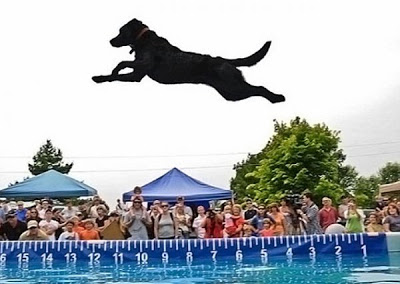 |
| Throw another dog in the (data) pool! (source) |
Why use it?
The patterns and groups we might look at within a meta-analysis of salivary cortisol (often used as an indicator of stress/welfare in dog research) are things like:
- Effects of different environments (do all the results from dogs housed in 'unfamiliar kennel environments' or 'familiar home environments' clump together at different or similar points within the range of values as a whole?);
- Effects of breed/age (is the range for labradors the same as that for german shepherds? Are all the young dogs in the same place as the old dogs?);
- Methodological aspects (such as what collection media was used: cotton swabs / synthetic rope / swabs with a saliva stimulant, etc. - does this effect where the cortisol results lie within the whole range?)
 |
| Nancy Dreschel |
Yep, you really can! Meta-analysis is a method used frequently in human health research and there are plenty of resources to refer to (check out 'further reading' section below). Of course, there are a few fancy statistical things you need to take into account and be aware of, to avoid tricksy sources of bias and subjectivity.
Fortunately, my collaborator extraordinaire, Dr Nancy Dreschel, from The Pennsylvania State University, has set us up to work closely with an extensively experienced biostatistician, so we should be safe from any meta-analytic traps for young players.
Nancy and I decided to undertake this project together after meeting at last year's Canine Science Forum. It really is the best conference ever.
You meet the greatest people there, no?!
Nancy and I decided to undertake this project together after meeting at last year's Canine Science Forum. It really is the best conference ever.
You meet the greatest people there, no?!
As I'm sure you already know, Nancy has done some very important research in the area of canine salivary cortisol, which I'll definitely write about in another post, another time (because cortisol in dog spit is SO worthy of being its own topic for discussion). She was recently chosen to receive the 2012 Excellence in Academic Advising Award from Penn State, and I'm so pleased to be working with her on this project.
So far we've had great support from our fellow researchers, who have shared the raw data from over 30 studies with us. This has allowed us to enter data that represents over 5,000 separate cortisol sample results. As Nancy pointed out to me in a recent conversation, that represents around 5L (or 1.3 US gallons) of canine saliva. Juicy!
Want to see one?
Well lucky for you - here are three meta-analysis papers I prepared* earlier: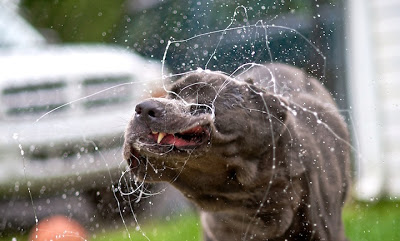 |
| This dog could probably provide 5L of spit without trying (source) |
Want to see one?
- Breed differences in dogs sensitivity to human points: A Meta-Analysis
These authors experienced a reluctance from other researchers to share data, which they handled with refreshingly direct honesty in their publication.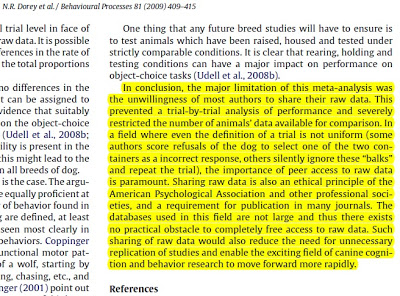
Excerpt from Dorey, et al. (2009)
- Personality Consistency in Dogs: A Meta-Analysis
I mentioned this in my last post, but it's worth mentioning again and a great example for anyone to look at, as it's readily available through open access journal, PloS-One.
- Animal-Assisted Therapy: A Meta-Analysis
I'm not sure it's compulsory to title your paper 'This Thing We Looked At: A Meta-Analysis', but it's seems kinda catchy. We'll probably follow suit.
So there you have it. I'm excited about dogs and I'm excited about throwing their data into the compiled data pool. I imagine it will look something like this when we're finished compiling:
 |
| Data "pooled". Snorrrt. Get it? Pooled? Ha! |
When I posted on Facebook about being excited about dogs and pools, you might have expected I'd talk about gene pools. Which is funny, because I wasn't intending to. Except that this week a study opened to collect data and the researchers involved in it ARE interested in gene pools, amongst other things - specifically the breeding, health, training and performance success of working farm dogs in Australia.
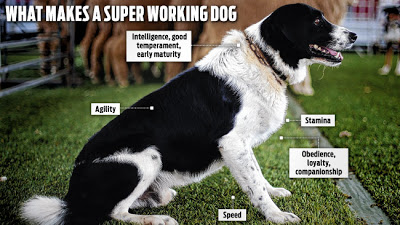 |
| The Farm Dog Project has launched (source) |
Researchers at the University of Sydney, including Dr Joanathan Early, are seeking information via an online survey from working farm dog handlers about their dogs. Jono explained to me that "the information from this initial online survey will be used to focus the next stages of the Farm Dog Project's research into the specific areas that farmers identify as central to realizing the potential in farm dogs."
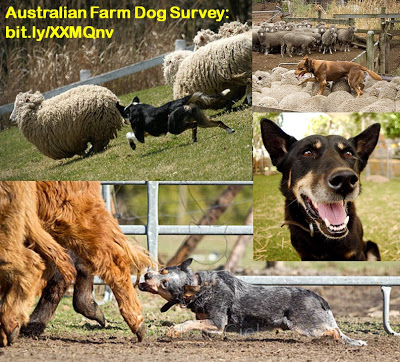 |
| If you have a working farm dog in Australia, you can take part in the online survey. |
This will aid the Farm Dog Project's later endeavours, helping to focus and design objective behavioural measurements for traits that are highly valuable and/or difficult to train (remember when we talked about 'drive'?), so efforts can then be turned to identifying the gene behaviour associations which can assist future breeding programs. Dr Early expects that "this information can then be used over the longer term of the Farm Dog Project's scope to develop Estimated Breeding Values (EBV's) or Genetic breeding Values (geBV's) so that working farm dogs can benefit from the same access to science and breeding technology as the livestock they herd". Interestingly, some Guide Dog organisations have been using EBV's to genetically improve their dogs for guiding people with a visual impariment for close to a decade now.
This exciting body of research offers huge potential to the future of Australia's working farm dogs and has been supported by the Rural Industries Research and Development Corporation (RIRDC); Meat and Livestock Australia (MLA) and the Working Kelpie Council.
I think I should stop now, this has turned into a long post, but it's tough with all this exciting canine science going around me! What's going on around you? Is it exciting too?
I truly hope so!
Mia
Further reading:
Liberati A., Altman D.G., Tetzlaff J., Mulrow C., Gøtzsche P.C., Ioannidis J.P.A., Clarke M., Devereaux P.J., Kleijnen J. & Moher D. & (2009). The PRISMA statement for reporting systematic reviews and meta-analyses of studies that evaluate health care interventions: explanation and elaboration, Journal of Clinical Epidemiology, 62 (10) e1-e34. DOI: 10.1016/j.jclinepi.2009.06.006
Dorey N.R., Udell M.A.R. & Wynne C.D.L. (2009). Breed differences in dogs sensitivity to human points: A meta-analysis, Behavioural Processes, 81 (3) 409-415. DOI: 10.1016/j.beproc.2009.03.011
Fratkin J.L., Sinn D.L., Patall E.A. & Gosling S.D. (2013). Personality consistency in dogs: a meta-analysis., PloS one, PMID: 23372787
Nimer J. & Lundahl B. (2007). Animal-Assisted Therapy: A Meta-Analysis, Anthrozoos: A Multidisciplinary Journal of The Interactions of People & Animals, 20 (3) 225-238. DOI: 10.2752/089279307X224773
© 2013 Mia Cobb
- 2014: Canine Science For All
Wendy74ca's photostream used with permission via Crazy and LittleHi Mia! I couldn’t agree with you more! It has been a long time since we chatted about what we’re up to. 2014 is off to a great start, apart from the fact that it is your summer...
- 2014: A Great Year For Canine Science
Hi Julie, Hope your festive season was fun and full of laughter. Happy new year to you! I've decided that 2014 is THE year for canine science! It's been a fairly long time since we compared notes on what we're doing at...
- Scientific American Gets A Dog
Paper and pen VS THE COMPUTERHi Mia, So I’m going to postpone the conversation I alluded to on Facebook. I wanted to ask you whether you opt for pen and paper when you're writing out blogs and work, or if you’re a computer gal, typing directly...
- The Heat(map) Is On... The Colours Of Canine Welfare.
Hey Julie, All those conferences sound completely AMAZING! I love that both dog urine and poo are totally appropriate topics for us to discuss in our conversations. All the other scientists are so jealous right now! I hope you've been well since...
- It's All About Objective Multiples...
sciseekclaimtoken-5036b68d5c7f8 First thoughts...Hey Julie! I hope you had a great weekend. Can I tell you more about assessing welfare? Hell to the yeah I can! (By the way, who gave you that photo of me working at 3:17am?!) I could...
